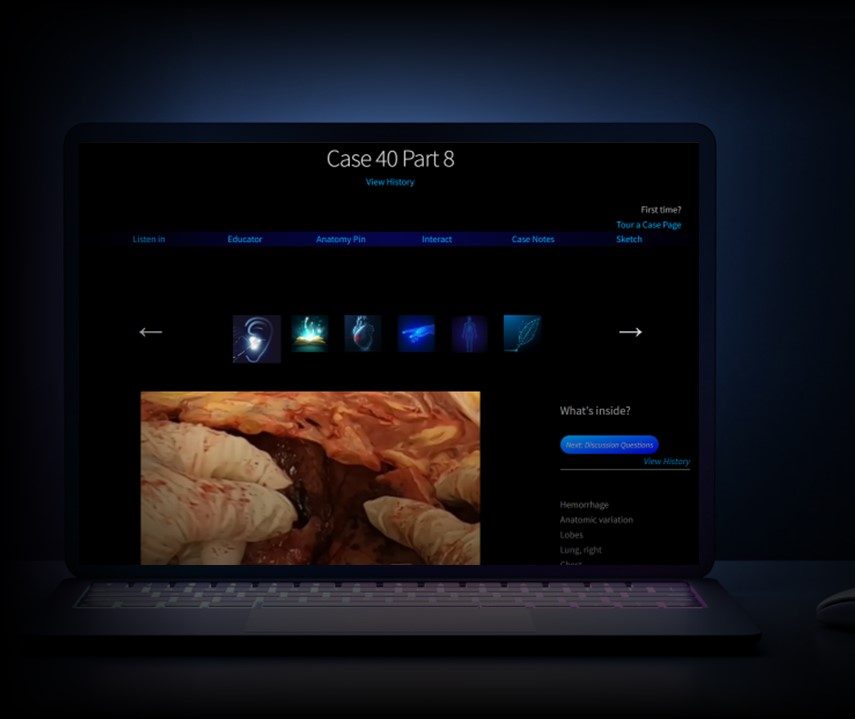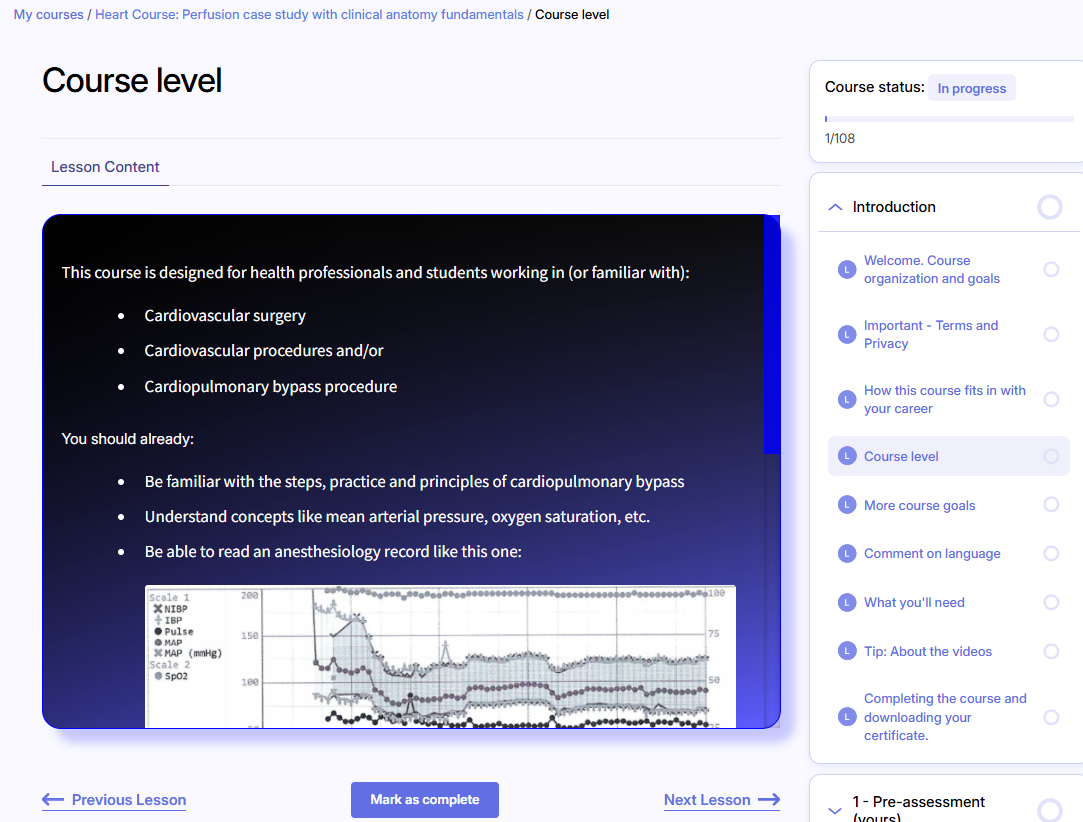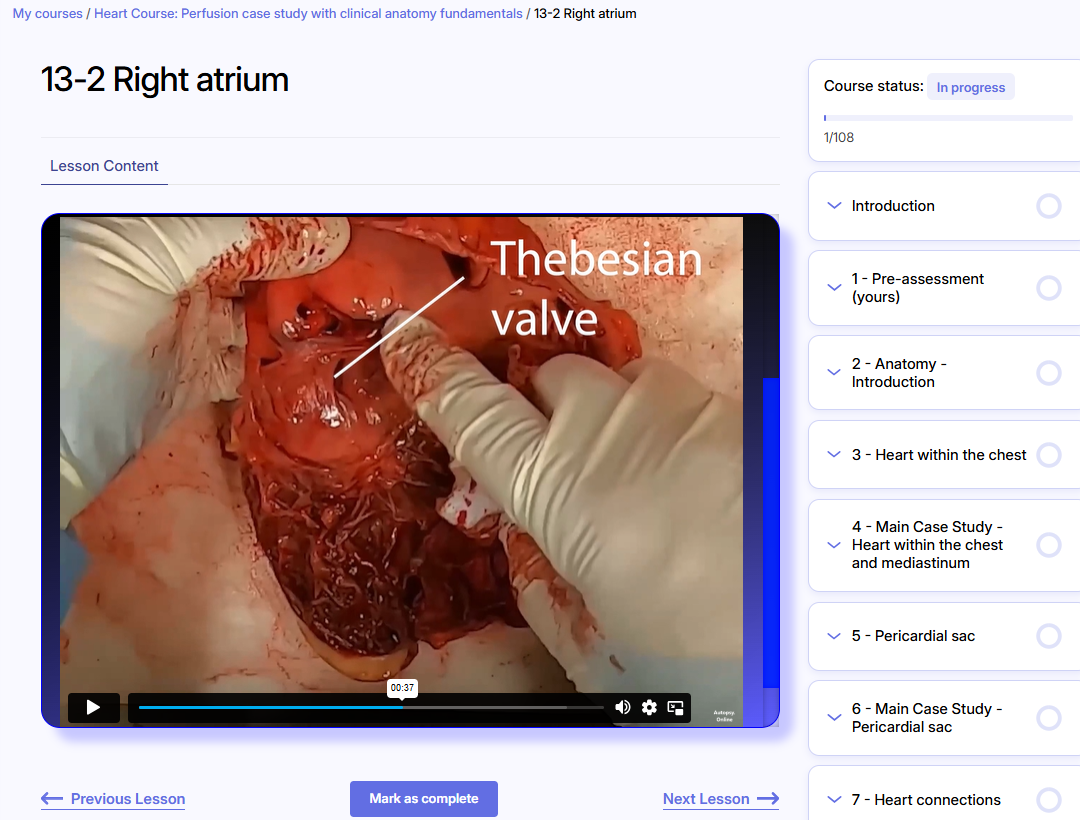Desktop devices
recommended.

Cost: $149
Self-paced online course
Access time to complete: 6 months

Real cases
View surgical changes in CPB
Training in real anatomy
About the Heart Course
The Heart Course:
- makes use of consented, real-case video footage
- employs case-based learning
- shows real cardiovascular anatomy with case applications in CPB and CV surgery
- utilizes varied cardiovascular case types, including CV surgery and CPB, to add depth to anatomy fundamentals
After completing the course, perfusionists, CV surgeons and related professionals will have
- a lifetime mental library of basic, real cardiovascular anatomy to ground future work with
- Digitized resources
- Radiology
- Simulation
- Product analysis
- improved ability (in CV surgery and CPB) to analyze and interpret:
- Surgical changes
- Complications
- Pathology
- Healing
- broadened understanding of the cardiovascular system in health and disease based on experience with real patients
- experience with evidence-based process to analyze complications and outcomes.
Preview
(Desktop recommended)






End of preview
Course Outline
Introduction
Important – Terms and Privacy
How this course fits in with your career
Course level
More course goals
Comment on language
What you’ll need
Tip: About the videos
Completing the course and downloading your certificate.
1 – Pre-assessment – Main Case Study
1-2 Preliminary clinical data – 1 – Main Case Study
1-3 Preliminary Clinical Data – 2
1-4 Preliminary Clinical Data – 3
1-5 Your assessment – Surgical issues
1-6 Your assessment – CPB issues
1-7 Your assessment – Anatomic issues
1-8 Your assessment – Pathologic issues
1-9 Another comment on language
2 – Anatomy – Introduction
3 -Heart within the chest
3-2 Heart within the chest
3-3 Sketch
3-4 Short Case – 1
3-5 Short Case – 1 – sketch
3-6 Short Case – 2
3-7 Short Case – 2 – sketch
3-8 Discussion and Review
4 – Main Case Study – Heart within the chest
4-2 Main Case Study – Sketch
5 – Pericardial sac
5-2 Normal pericardium
5-3 Sketch
5-4 Short Case – introduction – 1
5-5 Short Case – introduction – 2
5-6 Short Case – introduction – 3
5-7 Short Case 1 – Pericardial sac
5-8 Short Case 1 – Your assessment
5-9 Short Case 2 – Pericardial sac
5-10 Short Case 2 – Your assessment
5-11 Short Case 3 – Pericardial sac
5-12 Short Case 3 – Your assessment
5-13 Short Case 4 – Pericardial sac
5-14 Short Case 4 – Your assessment
5-15 Short Case 5 – Pericardial sac
5-16 Short Case 5 – Assessment
5-17 Short Case 6 – Pericardial sac
5-18 Short Case 6 – Assessment
5-19 Discussion
5-20 Review
6 – Main Case Study – Pericardial sac
6-2 Your Assessment
6-3 Your Analysis
6-4 Discussion
7 – Heart connections
7-2 Make your model
7-3 Aorta and Pulmonary Artery – inside the pericardial sac
7-4 Superior vena cava – inside the pericardial sac
7-5 Inferior vena cava – inside the pericardial sac
7-6 Pulmonary veins
7-7 Tour of the heart connections – explanted heart
7-8 Review your model
8 – Main Case Study – Heart connections
8-2 Discussion
9 – Heart external anatomy
9-2 Anatomy pin identification – activity
10 – Main Case Study – Heart external anatomy
11 – Coronary arteries
11-2 Coronary arteries – basic famework
11-3 Coronary arteries – in detail
11-4 Lab 1 – Heart orientation
11-5 Lab 2 – Coronary artery exposure
11-6 Lab 3 – Coronary artery exposure
11-7 Lab 4 – Coronary artery removal
11-8 Lab 5 – Coronary artery removal
11-9 Lab 6 – Coronary artery removal
11-10 Lab 7 – Coronary artery plaque assessment
11-11 Summary video
11-12 Short Case 1 – basic vessels
11-13 Short Case 2 – coronary artery plaque
11-14 Short case 3 – coronary arteries
12 – Main Case Study – Coronary arteries
12-2 More about the Main Case Study
13 – Heart internal anatomy
13-2 Right atrium
13-3 Valves
13-4 Fetal heart anatomy – introduction
13-5 Ductus arteriosus
13-6 Foramen ovale
14 – Main Case Study – Internal anatomy
14-2 Internal Anatomy 2 – Main Case Study
15 – Additional vessels
15-2 Branches of the aortic arch
15-3 Iliofemoral vessels
15-4 Short Case 1 – Additional vessels – 1
15-5 Short Case 1 – Additional vessels – 2
16 – Main Case Study – Central circulation
16-2 Additional vessels 2 – Main Case Study
17 – Main Case Study – Summary discussion
17-2 Additional clinical data
17-3 Additional anatomy data
17-4 The sequence of events
17-5 Discussion
17-6 More discussion
17-7 Clinical outcome
17-8 Final Comments
18 – Assessment
18-2 Tip: How do I check if I missed marking any lessons “Complete”?
Assessment: CPB: Case-based learning with clinical anatomy fundamentals
Course evaluation
